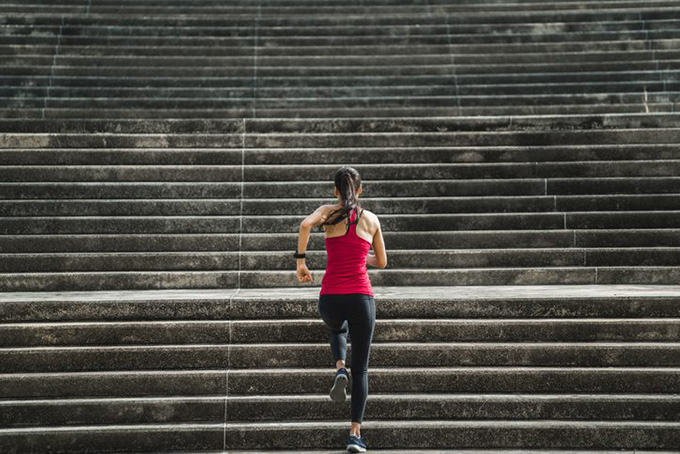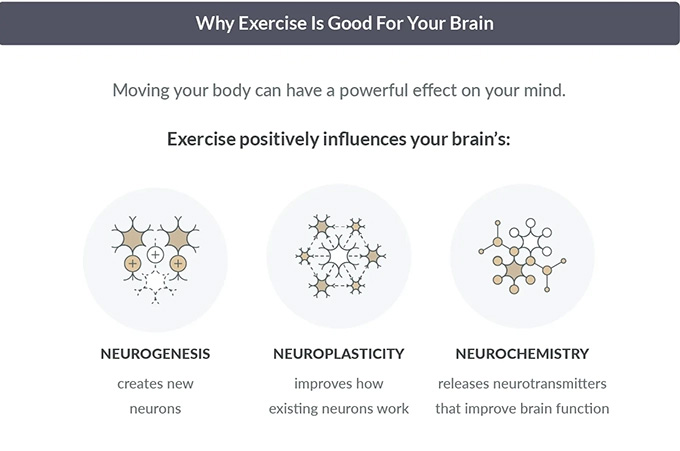
In addition to being beneficial for our body, physical activity also plays a crucial, often unsuspected, role in the development and modification of our brain.
Through the birth of new neurons (neurogenesis) and the creation of connections between neurons (synaptogenesis) and blood vessels which improve blood circulation to the brain (angiogenesis), physical activity sculpts the brain in the same way as the brain. muscle and helps improve our cognitive abilities.
Improved cognition and well-being through physical activity
Through these structural modifications (i.e. neurogenesis, synaptogenesis and angiogenesis, etc.), the impacts of physical activity are multiple.
On the cognitive level, numerous studies have highlighted a significant improvement in memory, attention, information processing speed and even creativity in physically active individuals. These functional changes are the direct result of structural and physiological modifications induced by physical activity.
Beneficial effects have also been observed in preventing age-related cognitive decline. A meta-analysis – a research work that conducts a statistical analysis by combining data from different studies* – including 15 longitudinal studies and totaling 33,816 participants aged over 55 (with no history of dementia) was conducted to evaluate the The influence of physical activity on cognitive decline.
The results show that individuals practicing regular and sustained physical activity reduced the risk of developing cognitive disorders by 38% compared to sedentary individuals.
On an emotional level, physical activity also influences our mental health , reducing symptoms of depression and anxiety, through the regulation of certain neurotransmitters (such as serotonin and dopamine).
Recent results have also shown that the emotional benefits of physical activity are particularly important in individuals with a low level of previous physical activity.
Furthermore, given that depression and anxiety impair important aspects of our cognition (such as attention, concentration, memory, speed of information processing or even decision-making), the Physical activity may play a protective role for individuals affected by these disorders.
In practice: what physical activity routine should you adopt?
Experts and the World Health Organization (WHO) recommend at least 150 minutes of moderate – intensity aerobic activity per week (or 75 minutes of more intensive activity) combined with strength training exercises twice per week. Per day, between 5000 and 7000 steps are recommended for adults.
Beyond physical and sporting exercises (corresponding to all aerobic activities, which require a significant supply of oxygen such as running or swimming, or planned, structured and repetitive muscular activities, with or without competitions), physical activity includes also the activities of daily life (walking, climbing stairs, mowing the lawn, gardening, cleaning, etc.).
Running, swimming, dancing – but also mowing the lawn, walking your dog, or taking the stairs rather than the elevator – are all accessible activities that can contribute to the health of our brain.
What brain mechanisms are at work?
Let’s explore how regular physical activity not only reshapes our figure, but also shapes the very architecture of our brain.
– The birth of new neurons
The birth of new neurons or neurogenesis has long been considered a process limited to the period of embryonic development. However, studies have shown that physical exercise stimulates neurogenesis in adults, particularly in the hippocampus, a key structure in memory and learning processes.
At the same time, activities requiring a significant supply of oxygen, such as running or swimming (also called aerobic exercises) promote the release of what we call growth factors (such as BDNF for English Brain- Derived Neurotrophic Factor , proteins essential for the survival and growth of existing neurons as well as the development of new brain cells.
– An increase in brain volume at all ages
Other research has shown that regular physical activity also changes the structure of our brain: it increases the volume of certain brain structures , notably the hippocampus and prefrontal regions. The hippocampus (located in the temporal lobe) is an essential structure for memory and learning while the prefrontal cortex is involved in so-called executive (high-level) functions such as reasoning, planning, inhibition, decision making, problem solving…
These changes were observed regardless of the age of the subjects , both in adulthood, in childhood, adolescence and even in the elderly. In the latter, regular physical activity could constitute a neuroprotective factor against the risk of developing neurodegenerative pathologies . Performing regular physical activities therefore contributes to brain health and development, both in young people and aging adults.
Work in animals suggests that these structural changes could be accompanied by an improvement in connectivity between different areas of the brain (by creating new synapses, these regions where interactions between nerve cells take place), which would make more efficient communication between more efficient neurons.
– Better oxygenation and irrigation
Finally, physical activity improves brain circulation. By increasing blood flow, physical activity (especially aerobic) stimulates the creation of new blood vessels . This process, called angiogenesis, improves the efficiency of the delivery of oxygen and nutrients to neurons.

Physical activity is also a driver of brain plasticity
By stimulating the creation of new neurons and the formation of synaptic connections, physical activity acts as a powerful driver of brain plasticity. We call “cerebral plasticity” the ability of the brain to remodel itself in response to environmental stimulation, by modifying the strength of connections between neurons or by forming new neuronal pathways.
This adaptability of the brain is crucial for learning, memory, but also reorganization after a brain injury. This ability is essential throughout life, enabling cognitive improvements and increased resilience to aging and neurodegenerative diseases.
In the context of neurological pathologies such as multiple sclerosis , adapted physical activity proves to be a valuable tool, not only for motor rehabilitation, but also for cognitive rehabilitation.
From now on, the mechanisms at work in the brain when we practice physical activity are well known. To fully benefit from these effects, it is not necessary to become a high-level athlete: a routine of moderate but regular physical activity is sufficient.
Author Bio: Beatrice Degraeve is a Teacher-Researcher in Neuropsychology, at the Catholic Institute of Lille (ICL)
This article was co-authored by Béatrice Degraeve (Catholic University of Lille, Lille, France), Bruno Lenne (Catholic University of Lille, FranceETHICS (EA7446) Group of hospitals of the Catholic Institute of Lille GHICL, neurology department, Lille, France), Caroline Massot (Group of hospitals of the Catholic Institute of Lille GHICL, rehabilitation department, France Université Catholique de Lille, Lille, France UPHF, LAMIH, Valenciennes, CNRS, UMR 8201, Valenciennes, France), Laurent Zikos (University Catholic of Lille, Lille, France).